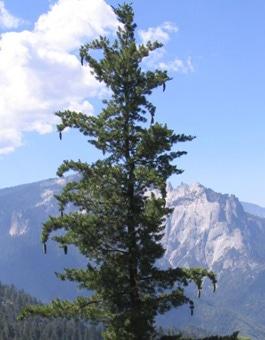

Largest of all pines
The sugar pine is the one of the largest trees, in both height and diameter, in old-growth stands. It provides clear wood in large dimensions and is easy to cut in any direction. This high dimensional stability puts it in demand for structural applications requiring minimal shrinkage, swelling, twisting and warping. It will take and hold paint better than most species. This quality makes the sugar pine ideal for millwork such as doors, sashes, trim, siding and panels. Other special uses include piano keys and organ pipes, which demand wood of especially straight, even grain.
Range
The native range of sugar pine is distributed almost continuously throughout the Klamath and Siskiyou mountains of northern California and southern Oregon, and on the western slopes of the Cascade Range where annual rainfall is 40 inches or more.
Character
The most impressive character of the mature sugar pine is its massive dimensions and huge asymmetrical limbs hung with long, cylindrical cones at their tips. Prized for their ornamental beauty, the cones of sugar pine are among the largest of any conifer, sometimes reaching up to 26 inches. Its seeds are eagerly sought by small rodents and birds, which aid in their dispersal.
Needles are in clusters of five and usually 2-4 inches long with white coloring on all three surfaces of each needle.
Understory
Associated species include mixed conifers like Douglas-fir, white fir and ponderosa pine. The woody understory is often cleared naturally by fire every 20-30 years.
Climate
The typical elevation range of the sugar pine is from 1,100 to 5,400 feet in the Cascade Range. Temperature and precipitation vary widely throughout the range of sugar pine, as it can thrive equally well in warm, dry summers and cool, wet winters.
Management
The sugar pine grows in a wide variety of soils derived from rocks of volcanic, granitic and sedimentary origin, but grows best in well-drained loams and sandy loams. Early growth of sugar pine is slow compared with that of ponderosa pine, but growth rates accelerate with age and are sustained for longer periods of time than those of associated species.